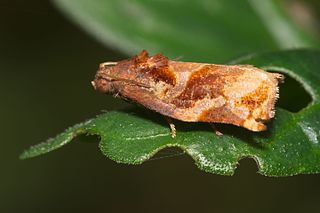Related Research Articles

Mangifera is a genus of flowering plants in the cashew family, Anacardiaceae. It contains approximately 69 species, with the best-known being the Common Mango. The center of diversity is in subtropical and tropical South Asia and Southeast Asia, while the highest number of species occur in India. They are generally canopy trees in lowland rainforests, reaching a height of 30–40 m (98–131 ft).
Indica is classical Greek and Latin for "of India". It may refer to:

Choristoneura occidentalis is a species of moth of the family Tortricidae. It is found in the Democratic Republic of Congo, South Africa, Tanzania and Gambia.

Mangifera indica, commonly known as mango, is a species of flowering plant in the sumac and poison ivy family Anacardiaceae. It is native to the Indian subcontinent where it is indigenous. Hundreds of cultivated varieties have been introduced to other warm regions of the world. It is a large fruit-tree, capable of growing to a height and crown width of about 30 metres (100 ft) and trunk circumference of more than 3.7 metres (12 ft).

Isotenes miserana is a species of moth of the family Tortricidae. It is found in the Northern Territory, Queensland, New South Wales and Victoria.

Cryptophlebia illepida is a species of moth in the family Tortricidae that is endemic to the islands of Kauaʻi, Oʻahu, Molokaʻi, Maui, Lānaʻi and Hawaiʻi. Common names include koa seedworm, klu tortricid, koa seed moth, litchi borer, litchi moth, macadamia nut borer and macadamia nut moth. It was first described by Arthur Gardiner Butler in 1882.
Adoxophyes privatana, the appleleaf-curling moth, is a moth of the family Tortricidae. The species was first described by Francis Walker in 1863. It is native to south-east Asia, where it has been recorded from Taiwan, Hong Kong, Hainan in China, Nepal, India, Sri-Lanka, Thailand, Vietnam, western Malaysia, Singapore, Sumatra, Java, Borneo, the Philippines and the Chagos Archipelago. It is an accidental introduction in Great Britain.
Archips micaceana is a moth of the family Tortricidae. It is found in China, Hong Kong, southern Vietnam, Burma, and northern Thailand. It is a minor pest of many agricultural crops.
Gymnoscelis imparatalis, the flower-looper moth, is a moth in the family Geometridae. It is found from the Indo-Australian tropics of India, Sri Lanka, east to the Society Islands and the Marquesas Archipelago. The habitat consists of both lowland and montane ecosystems.

Amorbia cuneanum, the western avocado leafroller moth, is a species of moth of the family Tortricidae. It is found from Baja California, Mexico, to south-western Canada. To the east, the range extends to Arizona and Idaho in the United States.
Platynota rostrana, the omnivorous platynota moth, is a species of moth of the family Tortricidae. It is found from the United States, south through Mexico and Central America to South America. Its native range also includes the West Indies. It has been recorded from Europe, where it may temporarily establish through accidental importation in tropical plants.
Lorita insulicola is a species of moth of the family Tortricidae. It is found on the British Virgin Islands and Guadeloupe.
Archips pensilis is a species of moth of the family Tortricidae. It is found in India.
Argyrotaenia sphaleropa is a species of moth of the family Tortricidae. It is found in South America, where it has been recorded from Colombia, Bolivia, Brazil, Peru, Uruguay and Argentina.

Homona tabescens is a species of moth of the family Tortricidae. It is found in south-east Asia, where it has been recorded from Java, Sabah, China, Thailand, Malaysia, New Guinea and Vietnam.
Homona trachyptera is a species of moth of the family Tortricidae. It is found in New Guinea, as well as Australia, where it has been recorded from Queensland.
Strepsicrates rhothia is a species of moth of the family Tortricidae first described by Edward Meyrick in 1910. It is found in Taiwan, Sri Lanka, India, the Democratic Republic of the Congo, Ghana, Madagascar, Mauritius and South Africa.
Pandemis chlorograpta is a species of moth of the family Tortricidae. It is found in China in the provinces of Heilongjiang, Beijing, Shaanxi, Jiangxi, Sichuan, Fujian and Zhejiang and in Japan.
Lasiodiplodia iraniensis is an endophytic fungus. It was first isolated in Mangifera indica, Eucalyptus and citrus species, Salvadora persica, Juglans species and Terminalia catapa in Iran. It has since been isolated in other plants in other continents, and is considered a plant pathogen. L. iraniensis is phylogenetically distinct from other species, but is closely related to L. theobromae; although conidia of L. iraniensis are smaller than the former. Dimensions of the conidia of L. iraniensis are similar to those of L. parva, but the subglobose conidia with rounded ends distinguish this species from L. parva.
Barriopsis iraniana is an endophytic fungus first found on Citrus, Mangifera and Olea species in Iran.
References
| Wikispecies has information related to Homona eductana |
| Wikimedia Commons has media related to Homona eductana . |
| This Archipini-related article is a stub. You can help Wikipedia by expanding it. |